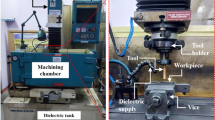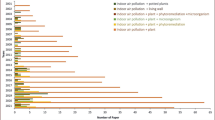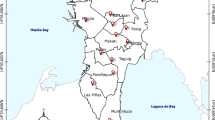Abstract
Total particulate matter (TPM), including condensable and filterable particulate matter (CPM and FPM), is one of the pollutants that need to be controlled in the coal combustion process. In this study, CPM and FPM were sampled from sixteen coal-fired power units and two coal-fired industrial units. The removal effects of air pollution control devices equipped in the units on the migration and emission of particles were investigated by analyzing samples from inlets and outlets of apparatus. The average removal efficiency of TPM by dry-type dust removal equipment, wet flue gas desulfurization devices, and wet-type precipitators reached 98.57 ± 0.90%, 44.89 ± 15.01%, and 28.45 ± 7.78%, respectively. The removal efficiency of dry-type dust removal equipment and wet-type precipitators to TPM is mainly determined by the purification effect of FPM and CPM, respectively, and both types of particles contribute to the removal efficiency of desulfurization systems to total TPM. The concentrations of CPM (12.01 ± 5.64 mg/Nm3) and FPM (1.95 ± 0.86 mg/Nm3) emitted from ultra-low emission units were the lowest, and CPM is the dominant particle, especially the higher proportion of organic components in CPM.









Similar content being viewed by others
Data availability
The datasets used and/or analyzed during the current study are available from the corresponding author on reasonable request.
References
Álvarez-Ayuso E, Querol X, Tomás A (2006) Environmental impact of a coal combustion-desulphurisation plant: abatement capacity of desulphurisation process and environmental characterisation of combustion by-products. Chemosphere (Oxford) 65:2009–2017
Anderson JO, Thundiyil JG, Stolbach A (2011) Clearing the air: a review of the effects of particulate matter air pollution on human health. J Med Toxicol 8:166–175
BP (2021) British Petroleum (BP) 2020 Statistical Review of World Energy 2020, British Petroleum (BP). Full report – Statistical Review of World Energy 2021 (bp.com)
Brook RD et al (2010) Particulate matter air pollution and cardiovascular disease: an update to the scientific statement from the american heart association. Circulation (New York N Y ) 121:2331–2378
Chen T-W, Chen J-C, Liu Z-S, Chi K-H, Chang MB (2021) Characteristics of PM and PAHs emitted from a coal-fired boiler and the efficiencies of its air pollution control devices. J Air Waste Manag Assoc (1995) 72:85
Dai H, Ma D, Zhu R, Sun B, He J (2019) Impact of control measures on nitrogen oxides, sulfur dioxide and particulate matter emissions from coal-fired power plants in Anhui Province, China. Atmosphere 10:35
Feng Y, Li Y, Cui L (2018) Critical review of condensable particulate matter. Fuel 224:801–813
Feng Y, Li Y, Zhang X, Zhang Z, Dong Y, Ma C (2020) Characteristics of condensable particulate matter discharging from a one-dimensional flame furnace firing lignite. Fuel (Guildford) 277:118198
Feng Y, Li Y, Zhang X, Su S, Zhang Z, Gan Z, Dong Y (2021) Comparative study on the characteristics of condensable particulate matter emitted from three kinds of coal. Environ Pollut (1987) 270:116267
Gao J, Wang K, Tong Y, Yue T, Wang C, Zuo P, Liu J (2021) Refined spatio-temporal emission assessment of Hg, As, Cd, Cr and Pb from Chinese coal-fired industrial boilers. Sci Total Environ 757:143733–143733
Hsu C-J, Chen Y-H, Hsi H-C (2020) Adsorption of aqueous Hg2+ and inhibition of Hg0 re-emission from actual seawater flue gas desulfurization wastewater by using sulfurized activated carbon and NaClO. Sci Total Environ 711:135172
Ko JH, Wang J, Xu Q (2018) Impact of pyrolysis conditions on polycyclic aromatic hydrocarbons (PAHs) formation in particulate matter (PM) during sewage sludge pyrolysis. Chemosphere (Oxford) 208:108–116
Li J, Li X, Zhou C, Li M, Lu S, Yan J, Qi Z, Shou C (2017a) Correlation between polycyclic aromatic hydrocarbon concentration and particulate matter during the removal process of a low-low temperature electrostatic precipitator. Energy Fuels 31:7256–7262
Li J, Qi Z, Li M, Wu D, Zhou C, Lu S, Yan J, Li X (2017b) Physical and chemical characteristics of condensable particulate matter from an ultralow-emission coal-fired power plant. Energy Fuels 31:1778–1785
Lin J, Fridley D, Lu H, Price L, Zhou N (2018) Has coal use peaked in China: near-term trends in China’s coal consumption. Energy Policy 123:208–214
Liu X, Gao X, Wu X, Yu W, Chen L, Ni R, Zhao Y, Duan H, Zhao F, Chen L, Gao S, Xu K, Lin J, Ku AY (2019) Updated hourly emissions factors for Chinese power plants showing the impact of widespread ultralow emissions technology deployment. Environ Sci Technol 53:2570–2578
Liu S, Wu Y, Xu Z, Lu S, Li X (2022) Study on characteristics of organic components in condensable particulate matter before and after wet flue gas desulfurization system of coal-fired power plants. Chemosphere (Oxford) 294:133668–133668
Meij R, Te Winkel H (2004) The emissions and environmental impact of PM10 and trace elements from a modern coal-fired power plant equipped with ESP and wet FGD. Fuel Process Technol 85:641–656
Morino Y, Chatani S, Tanabe K, Fujitani Y, Morikawa T, Takahashi K, Sato K, Sugata S (2018) Contributions of condensable particulate matter to atmospheric organic aerosol over Japan. Environ Sci Technol 52:8456–8466
Ouyang T, Xu J, Su Z, Zhao Z, Huang G, Mo C (2021) A novel design of low-grade waste heat utilization for coal-fired power plants with sulfuric acid recovery. Energy Convers Manag 227:113640
Qi Z, Li J, Wu D, Xie W, Li X, Liu C (2017) Particulate matter emission characteristics and removal efficiencies of a low-low temperature electrostatic precipitator. Energy Fuels 31:1741–1746
Ruan R, Liu H, Tan H, Yang F, Li Y, Duan Y, Zhang S, Lu X (2019) Effects of APCDs on PM emission: a case study of a 660 MW coal-fired unit with ultralow pollutants emission. Appl Therm Eng 155:418–427
Song J, Lu S, Wu Y, Zhou C, Li X, Li J (2020) Migration and distribution characteristics of organic and inorganic fractions in condensable particulate matter emitted from an ultralow emission coal-fired power plant. Chemosphere 243:125346
Sui Z, Zhang Y, Peng Y, Norris P, Cao Y, Pan W-P (2016) Fine particulate matter emission and size distribution characteristics in an ultra-low emission power plant. Fuel 185:863–871
Sun S, Liu W, Guan W, Zhu S, Jia J, Wu X, Lei R, Jia T, He Y (2021) Effects of air pollution control devices on volatile organic compounds reduction in coal-fired power plants. Sci Total Environ 782:146828
Tong D, Zhang Q, Liu F, Geng G, Zheng Y, Xue T, Hong C, Wu R, Qin Y, Zhao H, Yan L, He K (2018) Current emissions and future mitigation pathways of coal-fired power plants in China from 2010 to 2030. Environ Sci Technol 52:12905–12914
Wang H, Song Q, Yao Q, Chen C (2008) Experimental study on removal effect of wet flue gas desulfurization system on fine particles from a coal-fired power plant. Proc CSEE 28:1–7
Wang K, Wang S, Liu L, Yue H, Zhang R, Tang X (2016) Environmental co-benefits of energy efficiency improvement in coal-fired power sector: a case study of Henan Province, China. Appl Energy 184:810–819
Wang Q, Song X, Liu Y (2020) China’s coal consumption in a globalizing world: insights from multi-regional input-output and structural decomposition analysis. Scie Total Environ 711:134790–134790
Wu B, Tian H, Hao Y, Liu S, Liu X, Liu W, Bai X, Liang W, Lin S, Wu Y, Shao P, Liu H, Zhu C (2018) Effects of wet flue gas desulfurization and wet electrostatic precipitators on emission characteristics of particulate matter and its ionic compositions from four 300 MW level ultralow coal-fired power plants. Environ Sci Technol 52:14015–14026
Wu X, Liu W, Gao H, Alfaro D, Sun S, Lei R, Jia T, Zheng M (2021a) Coordinated effects of air pollution control devices on PAH emissions in coal-fired power plants and industrial boilers. Sci Total Environ 756:144063
Wu Y, Xu Z, Liu S, Tang M, Lu S (2021b) Emission of organic components and distribution characteristics of PAHs in condensable particulate matter from coal-fired power and industrial plants. J Energy Inst 97:109–116
Wu Y, Xu Z, Liu S, Tang M, Lu S (2021c) Emission characteristics of PM2.5 and components of condensable particulate matter from coal-fired industrial plants. Sci Total Environ 796:148782
Wu Y, Xu Z, Liu S, Tang M, Lu S (2021d) Migration and emission characteristics of N-alkanes and phthalates in condensable particulate matter from coal-fired sources. J Clean Prod 305:127203
Wu Y, Xu Z, Liu S, Tang M, Lu S (2022) Effects of the changes of load and flue gas temperature on the emission of particulate matter from the coal-fired unit. Aerosol Air Qual Res 22:210268
Yan Y, Yang C, Peng L, Li R, Bai H (2016) Emission characteristics of volatile organic compounds from coal-, coal gangue-, and biomass-fired power plants in China. Atmos Environ (1994) 143:261–269
Yang H-H, Lee K-T, Hsieh Y-S, Luo S-W, Li M-S (2014) Filterable and condensable fine particulate emissions from stationary sources. Aerosol Air Qual Res 14:2010–2016
Yang H-H, Arafath SM, Lee K-T, Hsieh Y-S, Han Y-T (2018) Chemical characteristics of filterable and condensable PM2.5 emissions from industrial boilers with five different fuels. Fuel 232:415–422
Yang Z, Wang C, Wang J, Liu L, Ge X, Zhang Z (2019) Investigation of formation mechanism of particulate matter in a laboratory-scale simulated cement kiln co-processing municipal sewage sludge. J Clean Prod 234:822–831
Zheng C, Hong Y, Liu S, Yang Z, Chang Q, Zhang Y, Gao X (2018) Removal and emission characteristics of condensable particulate matter in an ultralow emission power plant. Energy Fuels 32:10586–10594
Funding
The research was supported by the National Key Research and Development program of China (2018YFB0605200).
Author information
Authors and Affiliations
Contributions
Yujia Wu: conceptualization, formal analysis, data curation, and writing—original draft preparation. Zhenyao Xu: software. Siqi Liu: investigation. Minghui Tang: methodology. Shengyong Lu: supervision.
Corresponding author
Ethics declarations
Ethics approval
Not applicable.
Consent to participate
Not applicable.
Consent for publication
Not applicable.
Conflict of interest
The authors declare no competing interests.
Additional information
Responsible Editor: Shimin Liu
Publisher's note
Springer Nature remains neutral with regard to jurisdictional claims in published maps and institutional affiliations.
Supplementary Information
Below is the link to the electronic supplementary material.
Rights and permissions
Springer Nature or its licensor (e.g. a society or other partner) holds exclusive rights to this article under a publishing agreement with the author(s) or other rightsholder(s); author self-archiving of the accepted manuscript version of this article is solely governed by the terms of such publishing agreement and applicable law.
About this article
Cite this article
Wu, Y., Xu, Z., Liu, S. et al. The effect of air pollution control devices in coal-fired power plants on the removal of condensable and filterable particulate matter. Environ Sci Pollut Res 30, 70277–70287 (2023). https://doi.org/10.1007/s11356-023-27246-0
Received:
Accepted:
Published:
Issue Date:
DOI: https://doi.org/10.1007/s11356-023-27246-0




